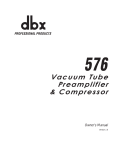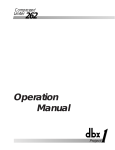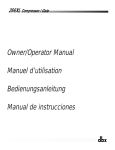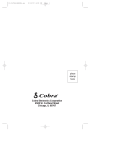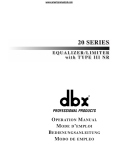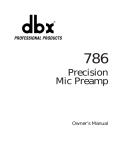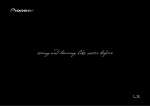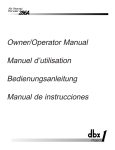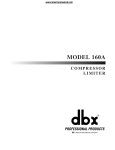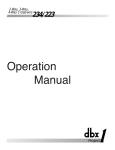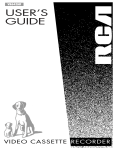Download dbx 566 Owner`s manual
Transcript
Dual Vacuum Tube Compressor Owner’s Manual Version 1.0 WARNING FOR YOUR PROTECTION, PLEASE READ THE FOLLOWING: WATER AND MOISTURE: Appliance should not be used near water (e.g. near a bathtub, washbowl, kitchen sink, laundry tub, in a wet basement, or near a swimming pool, etc). Care should be taken so that objects do not fall and liquids are not spilled into the enclosure through openings. POWER SOURCES: The appliance should be connected to a power supply only of the type described in the operating instructions or as marked on the appliance. GROUNDING OR POLARIZATION: Precautions should be taken so that the grounding or polarization means of an appliance is not defeated. The symbols shown above are internationally accepted symbols that warn of potential hazards with electrical products. The lightning flash with arrowpoint in an equilateral triangle means that there are dangerous voltages present within the unit. The exclamation point in an equilateral triangle indicates that it is necessary for the user to refer to the ownerÕs manual. POWER CORD PROTECTION: Power supply cords should be routed so that they are not likely to be walked on or pinched by items placed upon or against them, paying particular attention to cords at plugs, convenience receptacles, and the point where they exit from the appliance. These symbols warn that there are no user serviceable parts inside the unit. Do not open the unit. Do not attempt to service the unit yourself. Refer all servicing to qualified personnel. Opening the chassis for any reason will void the manufacturerÕs warranty. Do not get the unit wet. If liquid is spilled on the unit, shut it off immediately and take it to a dealer for service. Disconnect the unit during storms to prevent damage. FOR UNITS EQUIPPED WITH EXTERNALLY ACCESSIBLE FUSE RECEPTACLE: Replace fuse with same type and rating only. U.K. MAINS PLUG WARNING ELECTROMAGNETIC COMPATIBILITY A moulded mains plug that has been cut off from the cord is unsafe. Discard the mains plug at a suitable disposal facility. NEVER UNDER ANY CIRCUMSTANCES SHOULD YOU INSERT A DAMAGED OR CUT MAINS PLUG INTO A 13 AMP POWER SOCKET. Do not use the mains plug without the fuse cover in place. Replacement fuse covers can be obtained from your local retailer. Replacement fuses are 13 amps and MUST be ASTA approved to BS1362. This unit conforms to the Product Specifications noted on the Declaration of Conformity. Operation is subject to the following two conditions: ¥ this device may not cause harmful interference, and ¥ this device must accept any interference received, including interference that may cause undesired operation. Operation of this unit within significant electromagnetic fields should be avoided. ¥ use only shielded interconnecting cables. SAFETY INSTRUCTIONS SERVICING: To reduce the risk of fire or electric shock, the user should not attempt to service the appliance beyond that described in the operating instructions. All other servicing should be referred to qualified service personnel. MULTIPLE-INPUT VOLTAGE: This equipment may require the use of a different line cord, attachment plug, or both, depending on the available power source at installation. Connect this equipment only to the power source indicated on the equipment rear panel. To reduce the risk of fire or electric shock, refer servicing to qualified service personnel or equivalent. DECLARATION OF CONFORMITY NOTICE FOR CUSTOMERS IF YOUR UNIT IS EQUIPPED WITH A POWER CORD. ManufacturerÕs Name: ManufacturerÕs Address: WARNING: THIS APPLIANCE MUST BE EARTHED. The cores in the mains lead are coloured in accordance with the following code: GREEN and YELLOW - Earth BLUE - Neutral BROWN - Live As colours of the cores in the mains lead of this appliance may not correspond with the coloured markings identifying the terminals in your plug, proceed as follows: ¥ The core which is coloured green and yellow must be connected to the terminal in the plug marked with the letter E, or with the earth symbol, or coloured green, or green and yellow. ¥ The core which is coloured blue must be connected to the terminal marked N or coloured black. ¥ The core which is coloured brown must be connected to the terminal marked L or coloured red. CONDUCTOR WIRE COLOR Normal Alt L LIVE BROWN BLACK N NEUTRAL BLUE WHITE E EARTH GND GREEN/YEL GREEN This equipment may require the use of a different line cord, attachment plug, or both, depending on the available power source at installation. If the attachment plug needs to be changed, refer servicing to qualified service personnel who should refer to the table above. The green/yellow wire shall be connected directly to the unit's chassis. WARNING: If the ground is defeated, certain fault conditions in the unit or in the system to which it is connected can result in full line voltage between chassis and earth ground. Severe injury or death can then result if the chassis and earth ground are touched simultaneously. dbx Professional Products 8760 S. Sandy Parkway Sandy, Utah 84070, USA declares that the product: dbx 566 conforms to the following Product Specifications: Safety: EN 60065 (1993) IEC65 (1985) with Amendments 1, 2, 3 EMC: EN 55013 (1990) EN 55020 (1991) Supplementary Information: The product herewith complies with the requirements of the Low Voltage Directive 73/23/EEC and the EMC Directive 89/336/EEC as amended by Directive 93/68/EEC. dbx Professional Products Vice-President of Engineering 8760 S. Sandy Parkway Sandy, Utah 84070, USA September 25th, 1998 European Contact: Your Local dbx Sales and Service Office or International Sales Office 68 Sheila Lane Valparaiso, Indiana 46383, USA Tel: (219) 462-0938 Fax: (219) 462-4596 Table of Contents Introduction ................................................................................................................2 Features.......................................................................................................................2 Inspection ....................................................................................................................2 Warranty.....................................................................................................................3 Connections.................................................................................................................4 Compressor Controls .................................................................................................5 Rear Panel.................................................................................................................10 Specifications ............................................................................................................11 Settings Page.............................................................................................................13 1 Introduction Thank you for purchasing the dbx 566 vacuum tube compressor. The 566 combines world-renowned dbx compression with the latest in vacuum tube technology. The dbx 566Õs compression section incorporates the features that have made dbx the standard for high quality audio compression: Over Easyª compression curve, PeakPlusª limiting and the advanced dbx V1ª VCA module that ensures high system performance. Precision 1% resistors are used throughout the audio path to ensure performance stability and low noise. To ensure years of troublefree operation, each dbx 566 must pass a rigorous set of performance tests and a 24-hour burn-in period before it is shipped from the factory. We recommend that you take a moment to read through this operation manual. It provides valuable information that will assist you in setting up and operating your dbx 566. Features ¥ PeakPlusª Limiter ¥ Class A Vacuum tube stage with Drive control ¥ Selectable dbx OverEasy¨ compression curve ¥ Sidechain loop ¥ Multi-source VU metering and Peak indication ¥ Ready for optional dbx TYPE IVª Conversion System digital output module ¥ Stereo Link Inspection Verify that the 566Õs package contains the following: ¥ 566 Unit (according to Model number marked on package) ¥ AC Power Cord ¥ Operation Manual ¥ Registration Card ¥ Rack screws & washers If any of these items are missing, contact dbx customer service at (801) 568-7660. 2 Warranty This warranty is valid only for the original purchaser and only in the United States. We warrant dbx products against defects in materials or workmanship for a period of two years from the date of original purchase for use, and agree to repair or, at our option, replace any defective item, except external power transformers, without charge for either parts or labor. IMPORTANT: This warranty does not cover damage resulting from accident, misuse or abuse, lack of reasonable care, the affixing of an attachment not provided with the product, loss of parts, or connecting the product to any but the specified receptacles. This warranty is void unless service or repairs are performed by an authorized service center. No responsibility is assumed for any special, incidental or consequential damages. However, the limitation of any right or remedy shall not be effective where such is prohibited or restricted by law. Simply take or ship your dbx product prepaid to our service department. Be sure to include your sales slip as proof of purchase date. (We will not repair transit damage under the no-charge terms of this warranty.) dbx will pay return shipping. NOTE: No other warranty, written or oral is authorized for dbx products. This warranty gives you specific legal rights, and you may also have other rights which vary from state to state. Some states do not allow the exclusion of limitations of incidental or consequential damages or limitations on how long an implied warranty lasts, so the above exclusion and limitations may not apply to you. 3 Connections To connect the 566 to your system, refer to the following steps: ¥ Turn off all equipment before making any connections. ¥ Mount the 566 in a rack with the rack screws provided. The 566 can be mounted above or below anything that does not generate excessive heat. Ambient temperatures should not exceed 95¡F (35¡C) when equipment is in use. Although the unit is shielded against radio frequency and electromagnetic interference, extremely high fields of RF and EMI should be avoided where possible. ¥ Make audio connections via XLR, 1/4Ó TRS, or 1/4Ó TS plugs. Refer to Fig.1 for a typical studio connection layout. The XLR and 1/4Ó TRS connectors on the inputs and outputs can be used for balanced or unbalanced connections. However, the use of more than one connector at a time on the input pair could unbalance balanced lines, cause phase cancellations, short a conductor to ground, or cause damage to other equipment connected to the 566. ¥ Verify that the fuse installed in the pull-out fuse holder of the fuse receptacle matches the type and rating corresponding to the voltage in use as indicated on the rear panel of the 566. ¥ Apply power. Connect the AC power cord to the AC power receptacle on the back of the unit. Route the AC power cord to a convenient power outlet away from audio lines. The unit may be turned on and off from the rear panel power switch or from a master equipment power switch. Figure 1: A typical 566 connection scheme 4 Compressor Controls Figure 2: Front Panel Controls + 0 - THRESHOLD leds: The Ò+Ó led illuminates when the signal is above the OverEasy¨ portion of the compression curve and that the full compression ratio is in effect . If OverEasy¨ is disabled, this led indicates that the signal is above the level set by the Compressor Threshold control and that compression is occuring. The Ò0Ó led illuminates when the signal is in the OverEasy¨ portion of the compression curve. In this region the ratio varies as a function of signal level between 1:1 and the ratio set by the Ratio control. This led will not light when the OverEasy¨ function is off. The Ò-Ó led illuminates when the signal is below the level set by the Compressor Threshold control. This indicates that the Compressor is not compressing and is operating in its linear region. THRESHOLD control: This control sets the level above which compression occurs, and has a 60 dB range. OverEasy¨ switch: OverEasy¨ is a feature that provides a softer compression sound than hard knee does. OverEasy¨ smooths the transition from un-compressed to compressed. This smooth transition greatly reduces compression artifacts and allows faster attack times and higher compression ratios while still maintaining the natural characteristics of the signal. The switch lights to indicate OverEasy¨ processing is enabled. When conventional hard knee processing is desired, disable the OverEasy¨ function. See Figure 3 for a comparison of OverEasy¨ and hard knee compression curves. 5 1:1 Unity 1:1 RED Above Threshold 4:1 +5 20:1 0 :1 Rotation Point Threshold -5 4:1 +5 GREEN Below Threshold -15 -15 -10 −5 -5 0 −15 +5 +10 +15 +20 INPUT LEVEL (dB) :1 0 −10 -10 2:1 +10 AM B ER RED Above Threshold OverEasy Range EN +10 +15 RE 2:1 G +15 +20 OUTPUT LEVEL (dB) OUTPUT LEVEL (dB) +20 Below Threshold −15 −10 −5 0 +5 +10 +15 +20 INPUT LEVEL (dB) Figure 3: Hard Knee and OverEasy® Compression Curves RATIO control: This control selects the ratio between input and the output levels for signals above the level set by the Threshold control. It is adjustable between 1:1 (no compression) and infinity:1 (full compression). Note that when OverEasy¨ processing is selected, the ratio slopes gradually from the linear to the compressed region. As the signal exceeds the threshold, the ratio approaches the ratio set by the Ratio control. ATTACK control: This control sets the amount of time it takes the 566 to begin compressing a signal once the detector has sensed a signal above the threshold. The attack range is from 3 dB/msec for a tighter and more noticeable compression effect with very little overshoot to .04 dB/msec for a more gradual compression that preserves attack transients. A very fast attack setting will cause the 566 to act like a peak Limiter even though RMS (average level) detection circuitry is used. Slower attack settings cause the 566 to act like an RMS or averaging detecting Compressor/Limiter. AUTO switch: This switch overrides both the Attack and Release controls and enables preset program-dependent attack and release times. These times are derived from the characteristics of the input signal and continuously change to match its dynamics. The switch lights indicating the attack and release times are being automatically adjusted in a program-dependent fashion. Enabling the Auto function duplicates the Òclassic dbx soundÓ of the 566Õs forerunners which have become standards in the industry. RELEASE control: The Release control sets how fast the compression circuit returns the input to its original level. The release rate is from 250 dB/sec where compression follows the envelope of the program material very tightly to 5 dB/sec for very smooth compression. 6 INST Switch This switch selects the 1/4Ó Instrument input as the source for the compressor. DRIVE control This control sets the amount of gain that will be applied at the input of the vacuum tube stage present in the Compressor section. This control offers tube drive control (with its sonic stamp) to any signal routed through the Compressor. SC (SIDECHAIN) ENABLE switch This switch enables the Sidechain processing loop. The Sidechain in and out connectors on the 566 rear panel allow external processing of the CompressorÕs detector signal. This switch has no effect if there is nothing plugged into the Sidechain loop even though the switch will light when pressed. For more discussion of the Sidechain see page 16. SC (SIDECHAIN) MON switch This switch allows you to monitor the sound of the Sidechain processing. The switch will light when pressed to indicate that you are listening to the Sidechain; not the main signal path. CONTOUR switch This switch adds a gentle low frequency de-emphasis into the detector path (this is identical to having an equalizer in the Sidechain loop, only weÕve done it for you). This is extremely useful in keeping low frequency program material from ÒmufflingÓ or Òpunching holes inÓ the compressed signal. This feature allows faster attack times and higher compression ratios with less artifacts. The switch will light indicating contouring is activated. BYPASS switch This switch bypasses the compression section completely. The input is ÒhardwiredÓ to the output bypassing the tube amplification and VCA circuitry. This feature is very useful for setting optimum compression and gain settings because it gives you an instant reference to the amount of effect youÕve introduced to your signal. LEVEL control This is the output gain control (also known as a Ògain compensationÓ or Òmakeup gainÓ control). It is used to compensate for signal level lost due to compression and for excess gain contributed by the tube drive section. There is +/- 15 dB of gain control available with this knob. PeakPlusª Limiter THRESHOLD control This control sets the threshold level at which the PeakPlusª Limiter circuit becomes active. The threshold range is from 0 dBu to +22 dBu (off). The PeakPlusª Limiter stage is a unique program Limiter featuring Intelligent Predictive Limitingª. Its function is to monitor the input signal and intelligently predict the amount of gain reduction needed to keep the output signal below the ceiling set by the PeakPlusª control. 7 Note that since the PeakPlusª Limiter is a fail-safe Limiter it must come after the Output Gain control. If the Output Gain is set too high as compared to the PeakPlusª Level control, continuous limiting can occur. While PeakPlusª is typically used as a protective function, creative effects can be achieved by intentionally driving the signal into heavy PeakPlusª limiting. Great care has gone into the design of the PeakPlusª Limiter to keep it acoustically transparent. Appropriate use of it can protect your gear while keeping the signal free of artifacts. Peak Plusª also serves to prevent digital overload when used in conjunction with the dbx Type IVª Conversion System option. DRIVE LEVEL switch This configures the meter to show the signal level at the input to the vacuum tube. Note that high gain settings can result in excessive movement of the meter as the needle contacts the endpin. In this situation itÕs best to briefly check the drive level and then switch to one of the other meter modes. GAIN REDUCTION switch This configures the meter to show the amount of gain reduction due to compression. The lower markings on the meter show increasing gain reduction from right (0 dB) to left (-30dB). Note that when configured to the Gain Reduction setting, the meter swings from the fully right position and not the 0 dB position indicated on the top line of the meter. OUTPUT LEVEL switch This configures the meter to show the output signal level. This works in conjunction with the output level assignment switch on the back of the 566. When the rear switch is set to +4 dBu, a meter reading of 0 VU corresponds to +4 dBu output. When the rear switch is set to -10 dBV, a meter reading of 0 VU corresponds to -10 dBV output. LINK Switch: This switch changes the 566 from two independent compressors into a stereo compressor, and also links the two independent limiters into a stereo limiter. In stereo link mode a peak in either side of the compressor will activate both compressor channels equally. This helps to preserve stereo imaging. Channel One is the master and Channel Two is the slave except for the following controls: Sidechain Enable, Sidechain Monitor, Contour, and Bypass switches. Additionally, Channel Two's Compressor Threshold LEDs and PeakPlusª Limiter LED will be disabled, while both channels' Gain Reduction metering will identically indicate the amount of gain reduction occurring. It is important to note that while Channel One is the master as far as the controls go, both channels have equal precedence as far as signal processing is concerned. The dbx 566 uses True RMS Power Summingª, an extremely accurate and musical way to combine detector outputs in a stereo situation. The Link Switch will light to indicate that the 566 is in the stereo link mode. 8 DITHER switch This switch becomes active only when the optional dbx TYPE IVª Conversion System digital output module is installed. Refer to the manual for the TYPE IVª Conversion System for a description of the function of this switch. SHAPE switch This switch becomes active only when the optional dbx TYPE IVª Conversion System output module is installed. Refer to the manual for the TYPE IVª Conversion System module for a description of the function of this switch. 9 Rear Panel LINE INPUTS Both XLR and TRS 1/4Ó connectors allow balanced or unbalanced line-level devices to be connected to the input of the 566Õs Compressor section. The nominal input level can be set to either +4 dBu or -10 dBV with the +4 dBu/-10 dBV switch. INSTRUMENT INPUT The instrument input is configured as a high impedance, unbalanced input, with tip hot, sleeve and ring grounded. This input is for use with devices using passive or piezoelectric pickups (guitars etc.) LINE OUTPUTS Both XLR and TRS 1/4Ó connectors are provided for connecting either balanced or unbalanced linelevel devices to the 566. The nominal output level can be set to either +4 dBu or -10 dBV with the +4 dBu/-10 dBV switch. SIDECHAIN SEND The Sidechain Send and Return allow external processing of the CompressorÕs detector signal. The Sidechain Send is typically used to feed an external equalizer to produce compression that is triggered mostly by a specific frequency band. The Sidechain Send jack taps the signal before the tube section without interrupting the main output from the Compressor. This also allows the Sidechain Send to be used as an additional pre-tube line level output. The nominal output level is +4 dBu. SIDECHAIN RETURN The output of an external device used for Sidechain processing of the detector circuit is connected here. The nominal return level is +4 dBu. 10 Specifications COMPRESSOR Threshold Range: Ratio: Threshold Characteristic: Attack/Release Characteristic: Attack/Release Modes: Manual Attack Time: Manual Release Time: Auto Attack Time: Auto Release Time: Output Gain: -40 dBu to +20 dBu Infinity: 1 Selectable OverEasy¨ or hard knee curves AutoDynamicª Selectable Manual or Auto Scalable program-dependent. Typically 3 dB/msec to .04 dB/msec Scalable program-dependent. Typically 250 dB/sec to 5 dB/sec Program-dependent. Typically 15ms for 10 dB, 5ms for 20 dB, and 3ms for 30 dB. Program-dependent. Typically 125 dB/sec rate. -15 to +15 dB LIMITER Type: Threshold Range: Ratio: Attack Time: Release Time: PeakPlusª Limiter 0 dBu to > +22 dBu (off) Infinity : 1 Program-dependent, typically < 5 msec Program-dependent, typically 22 dB/sec SYSTEM PERFORMANCE DRIVE Control Range: LEVEL Control Range: 0.5 dB Bandwidth: Frequency Response: THD + Noise: Deviation From Linear Phase: Interchannel Crosstalk: +15 dB to +15 dB -15 dB to +15 dB 15 Hz to > 90 kHz +0/-0.5 dB <10 Hz to >200 kHz +0/-3.0 dB 0.04% typical (Drive control at minimum, Level control at maximum) 3.5% typical (tube saturation with Drive and Level controls at 50%) < 10 degrees, 20 Hz to 20 kHz. Typically -98 dB, 20 Hz to 20 kHz. POWER SUPPLY: Operating Voltage: Switchable between 100, 120, 230, and 240VAC, 50/60 Hz 11 Specifications Specifications (cont.) Power Consumption: Fuse: Mains Connection: 30 Watts max. 100/120V: 500mA 250V Slow Blow 5mm X 20mm 230/240V: T250 mA 250V 5mm X 20mm IEC 320 Receptacle PHYSICAL: Dimensions: Weight: Shipping Weight: 3.5ÓH X 19ÓW X 8ÓD 12 lbs (5.5 kg) 13 lbs (5.9 kg) Note: 0 dBu = 0.775V RMS. Specifications subject to change without notice. 12 dbx 566 Settings Page Photocopy this page and mark the settings you use for your sessions. Session: Date: Comments: Session: Date: Comments: 13 13 8760 South Sandy Pkwy. Sandy, Utah 84070 Phone: (801) 568-7660 Fax: (801) 568-7662 IntÕl Fax: (603) 672-4246 Questions or comments? E¥mail us at: [email protected] or visit our World Wide Web home page at: www.dbxpro.com
















